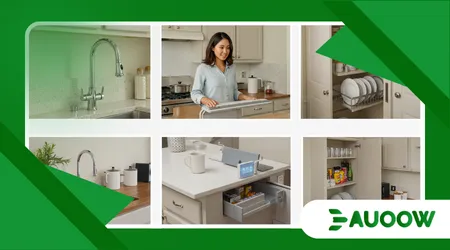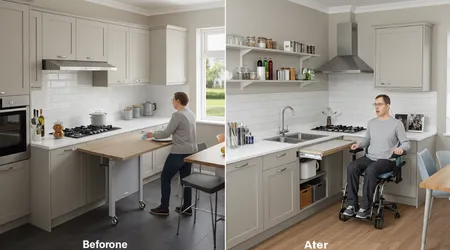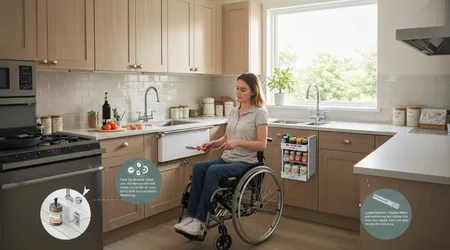How to Make Your Kitchen More Accessible Without Renovating

Make your kitchen more accessible without breaking the bank or tearing down walls.
Kitchens are the heart of homes, where meals are crafted, conversations spark, and memories simmer.
Yet, for people with mobility challenges, visual impairments, or dexterity issues, navigating this vital space can feel like threading a needle in a storm.
Renovations are costly often tens of thousands of dollars and not always feasible. The good news?
You can transform your kitchen into a more inclusive, functional haven with clever, low-cost tweaks.
This guide dives into practical, creative strategies to enhance accessibility, grounded in real-world solutions and a commitment to inclusivity.
From reimagining storage to rethinking tools, here’s how to ensure everyone can cook, gather, and thrive.
Accessibility isn’t just a buzzword; it’s a lifeline. According to the U.S. Census Bureau, over 40 million Americans live with disabilities, many facing daily barriers in their homes.
Kitchens, with their high cabinets and cramped layouts, often top the list of problem areas. But what if you could sidestep major construction and still create a space that works for all?
This article explores actionable steps, infused with ingenuity and empathy, to make your kitchen more accessible. Let’s roll up our sleeves and get started.
Rethink Storage for Easy Reach
High shelves are the nemesis of accessibility. If reaching for a cereal box feels like scaling a cliff, it’s time to rethink storage.
Lowering frequently used items to waist-level shelves or countertops can be a game-changer. Consider open shelving units, which eliminate the need to wrestle with cabinet doors.
For example, Maria, a wheelchair user from Chicago, swapped her upper cabinets for a rolling cart. She now stores plates and spices within arm’s reach, cutting prep time significantly.
This isn’t just convenience it’s empowerment. Pull-out drawers in lower cabinets also work wonders, letting you access pots without awkward bending.
Another trick is magnetic strips for knives and utensils, mounted at a comfortable height.
These small shifts ensure that make your kitchen more accessible becomes a reality without a contractor’s invoice.
Think of your kitchen like a well-choreographed dance: every move should feel fluid, not forced.
Storage isn’t just about height; it’s about visibility. Clear bins for dry goods let visually impaired users identify contents easily.
++ Adaptive clothing for people with physical disabilities: where to find it
Labels in large print or Braille add another layer of inclusivity. Why should anyone strain to find the flour?
Cost is a factor, too. A 2023 study by the National Association of Home Builders noted that 60% of homeowners prioritize affordability in home modifications.
Rolling carts start at $30, and pull-out drawers can be DIY-installed for under $100. These are investments in independence, not luxuries.

Optimize Countertops and Workspaces
Countertops are where the magic happens chopping, mixing, creating. But standard counters, often 36 inches high, can be too tall for seated users or too low for those who struggle to bend.
Adjusting workspace height without renovating is tricky but doable. Portable, adjustable-height tables are a brilliant workaround, offering flexibility for wheelchair users or those with back pain.
Take Leo, a retiree with arthritis. He uses a sturdy folding table set at 30 inches, perfect for his seated prep work. When not in use, it tucks away, preserving space.
Read more: Tips for creating a functional and accessible kitchen
This adaptability is key to make your kitchen more accessible without permanent changes.
Clear counter space is equally critical. Cluttered surfaces hinder movement and focus, especially for those with cognitive or visual challenges.
Designate a “landing zone” for appliances and tools, keeping the rest free. A lazy Susan for spices or oils maximizes efficiency in tight corners.
Lighting matters more than you’d think. Under-cabinet LED strips, costing as little as $20, illuminate workspaces without glare, aiding those with low vision.
It’s like turning on the sun for a midnight snack everything’s clearer, safer, easier.
Don’t overlook seating. A sturdy stool with a backrest allows users to rest during long tasks, reducing fatigue. Look for models with non-slip feet for stability.
These tweaks transform countertops into inclusive hubs, no sledgehammer required.
Upgrade Tools and Appliances for Ease
Kitchen tools can be allies or adversaries. Heavy pots, tiny handles, and complex gadgets often exclude users with limited strength or dexterity.
Swapping them for ergonomic alternatives is a low-effort way to make your kitchen more accessible. Lightweight, non-stick cookware reduces strain, while rocker knives allow one-handed cutting.
Consider appliances with universal design. Touchless faucets, activated by a wave, are a godsend for those with arthritis or mobility issues.
Brands like Moen offer models starting at $150, a fraction of renovation costs. Large, tactile buttons on microwaves or toasters also simplify use for visually impaired cooks.
Smart technology is a rising star. Voice-activated assistants like Amazon Echo can set timers or read recipes aloud, aiding those with memory or vision challenges.
Imagine a kitchen where Alexa reminds you the pasta’s done freedom in a speaker.
For dexterity, silicone grips or jar openers are lifesavers. These cost under $10 and fit most budgets.
A 2024 Consumer Reports review praised OXO’s Good Grips line for its intuitive design, blending style and function.
Appliances don’t need to be fancy. A kettle with an auto-shutoff feature prevents accidents, while a single-lever faucet eases operation.
These upgrades aren’t just practical; they’re invitations to cook with confidence.
| Tool/Appliance | Accessibility Feature | Approx. Cost |
|---|---|---|
| Rocker Knife | One-handed cutting | $15 |
| Touchless Faucet | Motion-activated | $150+ |
| Silicone Jar Opener | Enhanced grip | $8 |
| LED Under-Cabinet Light | Bright, glare-free | $20 |
Reorganize Layout for Flow
A kitchen’s layout can feel like a maze if mobility is limited. Tight corners and crowded paths hinder wheelchairs or walkers.
While you can’t move walls, you can rethink flow. Start by clearing floor space remove rugs or bulky furniture that create obstacles.
Widen pathways by rearranging appliances or tables. The Americans with Disabilities Act recommends 36-inch-wide paths for wheelchair access.
Measure your space and shift items to meet this benchmark. It’s like unclogging a river; movement becomes effortless.
For visual impairments, high-contrast markers on edges or floors guide navigation. Painter’s tape in bright colors works for temporary fixes, costing pennies.
These subtle cues make your kitchen more accessible without altering its core.
Think about workflow. Group frequently used items pots, utensils, spices near the prep area to minimize movement.
A rolling island, adjustable and mobile, adds flexibility for small kitchens. It’s a multitasking marvel, doubling as storage or a serving station.
Test the layout yourself. Walk through with a walker or close your eyes to simulate challenges. Empathy drives innovation here.
Small adjustments, like moving the coffee maker closer to the sink, can shave minutes off daily tasks.
Enhance Safety for All Users

Safety is non-negotiable. Kitchens, with their hot surfaces and sharp tools, pose risks for everyone, especially those with disabilities.
Simple tweaks can mitigate dangers and make your kitchen more accessible. Non-slip mats, like those from GelPro, provide cushioning and grip, reducing fall risks.
Fire safety is critical. A 2024 NFPA report noted that cooking fires account for 49% of home fire injuries. Install a fire extinguisher within reach, ideally at waist height.
Magnetic stove knob covers prevent accidental activation, perfect for cognitive impairments.
For sensory challenges, audible or vibrating timers alert users when food is ready, bypassing reliance on visual cues.
These cost under $15 and integrate seamlessly. It’s like giving your kitchen a sixth sense.
Grab bars, often associated with bathrooms, have a place here. Mount them near the sink or stove for support during transfers.
Peel-and-stick models avoid drilling, ideal for renters. Safety isn’t just physical; it’s peace of mind.
Consider temperature control. Anti-scald devices for faucets, costing around $30, prevent burns, crucial for those with reduced sensation.
Every detail counts in creating a kitchen that protects and empowers.
Foster Inclusivity Through Small Touches
Accessibility isn’t just about function; it’s about belonging. Small, thoughtful touches can make your kitchen more accessible emotionally and practically.
Large-print recipe cards or audio cookbooks invite everyone to participate, regardless of vision or literacy.
Color-coded utensils or plates aid those with cognitive challenges, making tasks intuitive.
For example, red handles for knives and blue for spoons create a mental map. It’s a simple hack with profound impact.
Involve family or housemates in the process. Ask for their input what frustrates them? What works? This collaborative approach ensures the kitchen feels like a shared space, not a clinical fix.
Think about sensory comfort. Dimmer switches for overhead lights, costing $25, let users adjust brightness, easing strain for light-sensitive individuals.
It’s like tuning a radio to the perfect frequency everyone’s comfortable.
Finally, celebrate progress. A kitchen that welcomes all is a triumph. Whether it’s a new utensil or a cleared pathway, each step forward is a victory.
Why settle for less when you can create a space that sings inclusivity?
Conclusion: A Kitchen for Everyone
Transforming your kitchen into an accessible sanctuary doesn’t require a wrecking ball or a fat wallet.
By reimagining storage, optimizing workspaces, upgrading tools, refining layout, enhancing safety, and adding inclusive touches, you can make your kitchen more accessible with intention and creativity.
These changes aren’t just practical they’re acts of care, ensuring everyone can savor the joy of cooking and gathering.
A kitchen is more than a room; it’s a stage for connection. With these strategies, you’re not just adapting a space; you’re opening doors to independence and belonging.
So, what’s stopping you from making your kitchen a place where everyone thrives? Start small, think big, and watch your kitchen transform.
Frequently Asked Questions
Q: Can I make my kitchen accessible on a tight budget?
A: Absolutely. Rolling carts ($30), silicone grips ($8), and DIY labels cost little but deliver big accessibility gains.
Q: How do I know if my kitchen layout is accessible?
A: Measure pathways (aim for 36 inches wide) and test navigation with a walker or closed eyes to identify barriers.
Q: Are smart devices worth it for accessibility?
A: Yes, voice-activated assistants like Alexa simplify tasks like setting timers, aiding those with vision or memory challenges.
Q: What’s the easiest first step?
A: Lower frequently used items to waist height or add clear bins for visibility quick wins with immediate impact.
